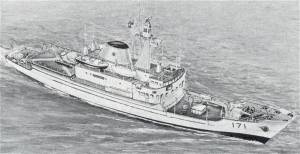The
1960s
The State of the RCN in 1963
Part 7: Afloat Logistic Support
Presentation given to the House of Commons on July 9th, 1963 by Vide-Admiral H.S. Rayner, Chief of Naval Staff.
|
|
|
|
|
A DESCRIPTION of the fleet would be incomplete without a few words on afloat logistic support.
NATO nations are individually responsible for the logistic support of the forces they provide to the Alliance.
Any maritime force should have afloat support facilities, for maximum operational effectiveness, flexibility and mobility. Wherever our combatant ships are to be found, and whatever they are doing, there must be satisfactory arrangements for their replenishment with fuel, ammunition and stores, and also for maintenance and repair facilities. Ideally this support should be afloat, and move to a distant area with the combatant ships. Afloat logistic support is also a very satisfactory means of dispersing stores and facilities from our shore bases.
|
Figure
12: HMCS CAPE BRETON, maintenance repair ship. (E-66886)
(Click image for a larger version) |
We now have two Cape class maintenance repair ships (Figure 12), which although old and slow, are adequate for their purpose. A new fleet replenishment ship, HMCS Provider, will enter service this year.
Aside
from their normal role of replenishment and repair these vessels,
particularly the Cape class, possess a good capability for carrying
Army troops and their equipment.
Figure 13 shows an artist’s conception of our new fleet replenishment ship, the Provider. The Provider will be able to replenish at speeds up to 20 knots and will carry fuel oil, diesel fuel, avgas, ammunition, spare helicopters, and dry stores.
|
Figure
13: HMCS PROVIDER, fleet replenishment ship, entering service
this year. Atrist's conception.
(Click image for a larger version) |
The Provider is a large ship, 22,000 tons, 551 feet in length, a beam of 76 feet and a draught of 30 feet. She will have a top speed of 20 knots and a crew of 159. She is being built in Lauzon, Quebec.
Another
interesting vessel under construction in Esquimalt, is this research
ship (Figure 14). She will be operated on the Pacific Coast
by the Navy, as required by the Pacific Laboratory for the Defence
Research Board.
She
will be 235’ long, 38’ beam and displace 1,600 tons. She
will have a diesel-electric drive, be very quiet up to six knots
and have a top speed of 16 knots. She will have a long endurance,
so 60 days of refrigerated storage is being provided, and she is
also being stabilized. She will have accommodation for 12 scientists
and a crew of 26.
|
Figure
14: Research ship under construction at Esquimalt.
(Click image for a larger version) |
>>>
Go to Next Page



